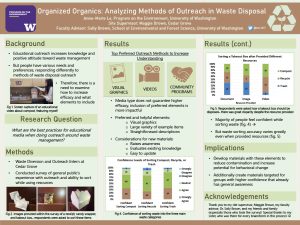Organized Organics: Analyzing Methods Of Outreach in Waste Disposal
A variety of outreach media regarding waste disposal is created for the general public, raising awareness to divert products from landfills. Because individuals respond differently to different methods of outreach, understanding the essential elements to include in all variations of education ensures the efficacy no matter the audience. The aim of this study was to examine how people interacted with educational resources and identify what features across various formats of outreach were most beneficial to be included when developing future materials. To accomplish this, I worked as the waste diversion and outreach intern for Cedar Grove, where I helped customers with contamination issues and identified what resources could benefit the customer. Additionally, I conducted a survey which provided respondents with a resource, either a video, text-based document, or image-based poster. I then asked respondents to sort commonly misplaced items and examined how the resource helped them do so. Between the example resources offered, none were found more effective than the others to help individuals sort commonly misplaced items. Elements found helpful or necessary regardless of resource type were clear images, variety of items included, and straightforward labels. A review of people’s confidence in their ability to sort waste revealed gaps in knowledge. New materials need to be created that evaluate existing knowledge, complimentary to the current resources designed to simply raise awareness. Developing materials with these elements in consideration will increase the efficacy to reduce overall contamination and increase the potential for lasting behavioral change.
